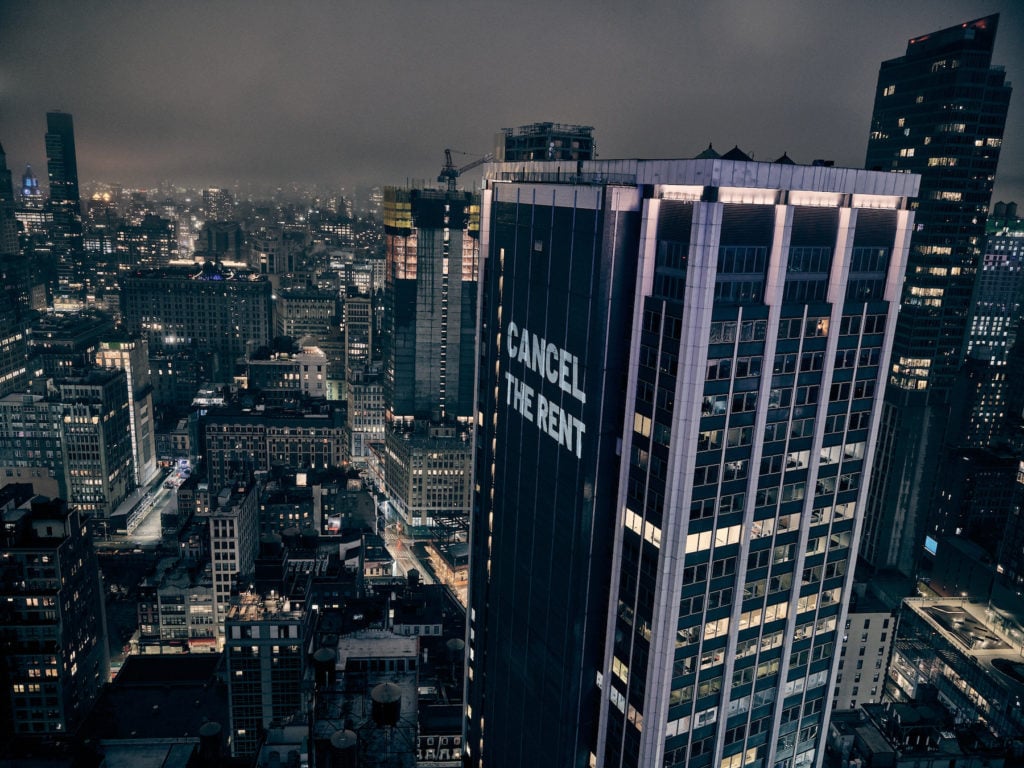Every Monday morning, Artnet News brings you The Gray Market. The column decodes important stories from the previous week—and offers unparalleled insight into the inner workings of the art industry in the process.
This week, examining where galleries would stand after a seismic urban realignment…
REAL ESTATE OF THE UNION
On Tuesday, Matthew Haag of the New York Times considered the consequences a possible work-from-home revolution would have for the city and state of New York. Although his analysis begins in real estate, it soon expands to include such foundational elements of metropolitan life as public safety, transportation, and sanitation—all of which could be starved for public funding if enough employers downsize or eliminate their New York office spaces (and the associated tax bills that come with them). And while these changes would affect every industry to varying degrees, few others—and possibly none—would be affected in quite the same way as the gallery system.
Zooming out from New York for a moment, Big Tech has been leading the charge toward long-term remote work in the broader US since the start of the shutdown. Facebook and Google recently announced they will permit employees to work from home for the remainder of 2020. Twitter did them one better, as CEO Jack Dorsey informed staffers on Tuesday that, with the exception of those responsible for maintaining data servers or other physical assets, employees can telecommute permanently. (Note: It is not especially clear to me where the boundary lies between “can” and “must” here.)
Although each of those tech Goliaths has had a New York office for years, the majority of their staff was siloed at their respective Bay Area compounds prior to the crisis. Haag instead focused on a group of executives at several major employers headquartered in Manhattan, most notably from within the finance industry.
JP Morgan Chase already notified its approximately 180,000 employees that it was, in Haag’s words, “reviewing how many people would be allowed to return” to its offices even after the shutdown lifts. Barclays and Morgan Stanley have not gone that far yet, but Barclays CEO Jes Staley went on the record to say that “the notion of putting 7,000 people in a building”—which the bank has been doing near Times Square for years—“may be a thing of the past.”
Even if this potential work-from-home reckoning were to stay confined to high finance, its effect on New York real estate would still be colossal. JP Morgan Chase, Barclays, and Morgan Stanley together lease more than 10 million square feet of office space in Manhattan. That sum equals “roughly all the office space in downtown Nashville,” according to Haag.
But since finance and tech have become the entrepreneurial paradigms for an increasing number of industries worldwide over the last four decades (including the arts), you’d better believe that if Wall Street and Silicon Valley start riding the wave of large-scale remote work for the long term, others will join them ASAP. And that would put galleries in a unique position in New York and around the world.

The Illuminator projects the “Cancel the Rent” message on Saturday, March 28, in Manhattan. Image courtesy the Illuminator.
TAKE IT OR LEAVE IT?
Since the world’s developed nations transitioned from being primarily manufacturing economies to primarily service-and-information economies starting in the 1990s, crises have forced decision-makers at almost every company to ask the same cost-conscious question: How much of my business genuinely demands gathering staff and/or clients into a communal physical space?
In more and more cases in every year since, the answer has landed somewhere between “not very much” and “basically none.” This answer has also taken on even greater importance in light of the distressing spike in real-estate prices, which have doubled in the US since 2000 (and made rent relief a central issue in the current crisis). No wonder we’re now at a point where some of the biggest firms in some of the world’s biggest cities are weighing dramatically reducing their real-estate footprint, if not erasing it almost entirely.
Assuming they do—and as I wrote a few weeks ago, I rarely bet against companies doing whatever benefits their bottom line (especially once their execs start openly discussing it with the press)—their choice unquestionably strengthens galleries’ negotiating positions on rent once the crisis starts to fade. Millions of square feet of real estate would become tenant-less not just in Manhattan, but in major art hubs across the globe. Prices would plummet as a result of the broader commercial exodus, granting dealers more leverage on their leases than they’ve had in years.
Of course, plenty of galleries won’t manage to survive the crisis at all. But those who do should be able to either favorably renegotiate with their landlords on their existing spaces, or upgrade to a new home base for the same amount (or possibly less) than before. Similarly, new galleries should be able to set up shop at rates that many of their forebears would have agreed to wire-walk between office towers for the opportunity to lock in.
None of this is revolutionary thinking on my part. However, it’s worth highlighting that this seemingly obvious benefit carries with it an asterisk the size of an asteroid.

Damien Hirst, The Golden Calf (2008). Image courtesy of the artist and Sotheby’s.
PRISONERS OF WEALTH
Although galleries and auction houses in Europe and Asia are beginning to open again, it remains unclear when their counterparts here in the US will be allowed to stir their physical spaces out of state-mandated shutdown. In the interim, their forced march into exhibiting exclusively online has reinforced the enduring vitality, if not the near necessity, of the IRL art experience.
Yes, online sales are increasingly common and increasingly lucrative for dealers. But most artists still want to show their work in a physical space, and most enthusiasts still want to see it there at least some of the time. These preferences plunge galleries into the shrinking pool of businesses who stand to lose something major by opting out of brick-and-mortar locations. And unlike for so many white-collar firms, it’s important that those locations still occupy relatively desirable neighborhoods in premier cities.
When it comes to metropolitan real estate, then, galleries remain a somewhat captive client.
Sure, there will always be a handful of dealers who can draw collectors, curators, and other power players to more remote neighborhoods within art capitals, or even to locations outside them. I always remember Jeffrey Deitch, all the way back in 2015, talking about how he was “more stimulated by the experience of going into this alley behind the liquor store [on the Lower East Side] to get to Ramiken Crucible” than by almost anything else on the art scene, including the gleaming blue-chip galleries in the poshest neighborhoods. Art fairs (remember those?) like NADA Miami and Liste also regularly include respected dealers based in non-art hubs like Athens, Georgia and Cluj-Napoca, Romania.
But the number of successful galleries situated off the beaten path is small, and their prospects for both visibility and long-term sustainability remain questionable. Accessibility and density matter in the gallery sector. You can entice die-hards like Deitch to go on an urban scavenger hunt for one special space, but otherwise, galleries cluster together into the most attractive districts they can afford for a good reason: they want to be as close as possible to where buyers want to spend the rest of their time.
Even if millions of square feet of office space change hands or go vacant, the average high-net-worth individual is still going to want to live in premier cities like New York, London, and Los Angeles rather than moving to the suburbs. This is partly why it was laughable that Amazon’s infamous nationwide contest for HQ2 would end anywhere other than where Jeff Bezos, newly single and newly crowned the world’s wealthiest man, would want to be based himself.
Remember, most New York collectors blanched at crossing into Brooklyn or Queens even before anyone outside of the healthcare industry had ever heard the ‘c’ word. The challenge will be even starker now that the very act of leaving your home feels like the climactic sequence in a zombie apocalypse flick.
All of the above means that you’re unlikely to see a slew of Lower East Side galleries move to the outer boroughs, let alone New Jersey or Connecticut after the crisis fades. The same is true in every other art capital around the world. Landlords know this as well as I do, which puts a distinct handicap on dealers’ negotiating power even if Manhattan becomes a corporate wasteland.
It’s impossible for me to say how much leverage galleries would ultimately gain from a mass corporate migration away from cities. At a certain point, their priority to stay metropolitan will counteract the strength provided by all those empty office towers. But wherever equilibrium would be in this new vision of real estate, the process of getting there would once again prove that, in the 21st century, the art market remains an industry unlike any other.
[The New York Times]
That’s all for this week. ‘Til next time, remember: the only constant is change.








